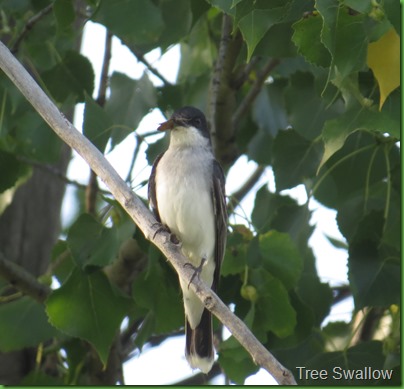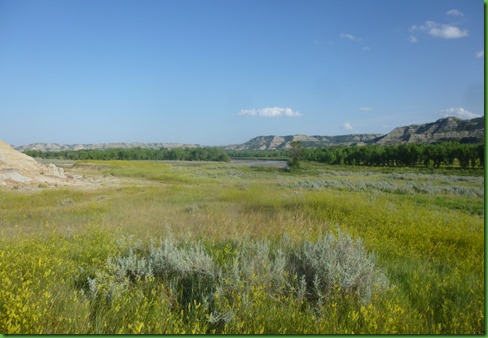Tuesday July 29, 2014
Juniper Campground North Unit
Theodore Roosevelt National Park
North Dakota
The North Unit Park Drive is not a loop. It runs 13.7 mile from the visitor center and dead ends on a high butte overlooking the Oxbow in the Little Missouri River.
There are several lovely pull outs, many informational pullouts and a couple of short trails that run off of the drive. David wants to look for big horn sheep but he didn’t really want to get up early enough to see them grazing just after sunrise so he has decided that we will do the drive West from the campground this morning and East of the campground later. The western section rises up to the high butte from the river bottom where we are now.
The campground is at mile post 4.6. Directly across from the campground entrance is the Cannonball Concretion Pullout but he wants to do that last so on we go climbing climbing into the sky and skipping everything between here and Milepost 7.8, River Bend Overlook.
This is a gorgeous spot and the CCC boys have erected a stone shelter with a fabulous view of the Little Missouri River 550 feet below. The overlook shelter is constructed of sandstone slabs and was built in 1937. The flat are on either side of the river is the floodplain.
The Little Missouri River below is variable in size and depth over the course of a year. In the spring and early summer, it may be bank full (7-8 feet deep) and strong enough to transport entire cottonwood trees they say. But right now it is very very shallow. Even later in the summer they say it may stop flowing altogether on the surface.
David walks around the shelter to the right luckily and as he comes across the back next to the edge, he sees someone has very recently posted a sign written on notebook paper warning of a rattle snake in the shelter’s outside rocks around the corner. David peeks around and sure enough, the rattles are hanging out. He turns around and goes back the way he came. Very nice and thoughtful of whoever discovered this to post the sign which will protect everyone coming from that direction at least until it rains.
While we are here, David is scanning all the rocks in every direction for big horn sheep. No success. But we do see how wide, flat and shallow the Little Missouri is.
Our next stop is at milepost 12.4 entitled Edge of Glacier Pullout. Here there are some glacial erratics in the prairie grasses which cover the top of this butte. These scientists say were drug here and left from up in Canada. The glaciers stopped just below the north unit and did not affect the south unit geology. I’m told that is why the north unit has such a much more rugged look. It is interesting to see these giant stones sitting in a sea of yellow sweet clover.
Of course each time we stop we have to look out with our binoculars to the south on the rocks to check for Big Horn Sheep.
The end of the road is the Oxbow Overlook. Even though it is almost 11:00 and the sun is beating down, we hike out the Sperati Trail which goes through the Prairie atop the Butte about a mile hopefully to get the best look at the oxbow. Based on the intensity of that sun, I’d say this butte is about 1000 feet from it. This trail feels a lot longer than 1 mile.
Some folks obviously don’t mind this heat at all.
The story here is pretty interesting. Apparently prior to the ice age, the Little Missouri joined the Yellowstone River near Williston ND and flowed on to the Hudson Bay. A southward advancing glacier blocked the northern route of the ancient Little Missouri just west of here. The glacier dammed the river and formed a temporary lake which increased in depth until it overflowed to the east over the containing walls of the ancient valley. When the glacier melted, the Little Missouri did not return to its old river bed. Instead it continued to flow eastward rapidly eroding downward over the steeper course. The river found a new course through the gap here between Sperati Point to the west and the Achenbach Hills to the east. It now empties into the Gulf of Mexico via the Missouri and Mississippi Rivers. Isn’t it amazing what geologists can tell us.
The oxbow is really cool. Sure wish we could kayak. If you want to kayak, come earlier in the year when the water is higher.
It seems a forever walk back under the HOT sun.
Back in the car with the AC on HIGH, we head down toward the campground. The scenery on the way is eye popping.
But we’re finished for this day until the sun goes much further down in the sky.
After dinner, at 6:00 we go out to do the lower part of the drive. From the campground we head down to milepost 2.1, the Longhorn Pullout.
South of the road is the floodplain of the river. This terrace is covered by river sediments deposited during the last 5,000 years. The predominant silver-gray sagebrush provides food for mule deer and shelter for birds and other small animals.
At this spot, supposedly a herd 15 to 25 long horn cattle can be seen in the early mornings and late afternoons. Right now these smart cattle are in the shade of the cottonwood trees in the distance. The buttes are on the far side of the river. I’ve been hoping to see a real live longhorn not in some sort of confinement. But not today. We either have to get out earlier – pretty near impossible for David – or skip the ranger talks in the evening and come out then, also hard for David.
Turning back up the drive we stop at mile post 2.8 marked as the Slump Block Pullout which describes another interesting geological anomaly. Layers of weaker sediments sometimes give way due to the weight of overlying rocks. As a result, the rocks above may slide or tumble down below the weaker layers. They slump downhill. The sign gives an explanation of what happened and an excellent graphic so I can understand that it isn’t a landslide. It’s a slump.
The slump, of course, is resting in front of the rest of the formation but it appears that neither of us took a distant picture of the slump section in front of the larger formation but you can see how the slump is tilted back and the larger formation from which it came is erect. So we have a close up but not a distance shot of the slump.
Here’s the slump. Notice the sloping lines and at the very top the dark green trees.
I’m pretty sure this is the area that it slumped from since the dark green trees on that little hill on the left is the slump now that it has been covered with vegetation on the south side. See the same lines on the erect formations. Really cool no?
But wait until you see this. Our last stop is the pull out just across from the campground entrance. The Cannonball Concretion pullout is the most fun of them all.
Round concretions like the ones on the ground and weathering out of this cliff ere formed by the cementing actions of ground water. Although most of them are round, they can actually be any shape.
Before the erosion of the badlands began, groundwater seeped slowly through these sediments for millions of years. The water contained minerals which, when they were precipitated out of solution, cemented the sand grains together. As a result, even though these concretions contain the same sized sand grains as does the surrounding sand, they are much more resistant to erosion. The concretions are weathering out of a 30 to 40 foot thick sandstone bed – an ancient river deposit.
The concretions are formed within rocks, shale,sandstone, clay etc, by minerals being deposited around a core. More concretions will be exposed here as erosion continues. Too cool!
They are on both sides of this large formation.
The effects of water in this entire park are amazing but none more fantastic than here. We walk around on the other side not facing the pull out parking and find not only more concretions but beautiful artwork.
This is one of my favorites. Look at this design, compliments of water.
Not quite tall enough for David
Our final find of the day is driving down the campground road when we happen on a turkey jam. We surprise a flock of turkeys and they us. I wasn’t fast enough to get the group together before they panicked and started running down the road but here are a few of them once they got over most of their fright. Although one of them just sat down in the middle of the road. Turkeys really are so funny.
Eventually they head off into the grasses and the little ones are nearly lost from sight.
We have one more day here in the North Unit and we plan to get out early. Hmmmm how likely is that really??










































































